|
2000
DECEMBER
CLOVIS CULTURE
THE CLOVIS CULTURE
IS THE OLDEST RECOGNIZED CULTURAL TRADITION IN NORTH AMERICA DATING TO
APPROXIMATELY 14,000 YEARS AGO
|
|
EAST
WENATCHEE
CLOVIS SITE
DOUGLAS CO.,
WASHINGTON
OWNED
BY STATE OF WASHINGTON
One of the most spectacular archaeological discoveries ever made in the
study of Early Paleo bone and stone artifacts occurred near East
Wenatchee, Washington in 1987. The site is located in an apple orchard
near the Columbia River in central Washington. The initial find was made
by workers who were digging a ditch for an irrigation pipe line.
Until the East Wenatchee Clovis site was discovered the
northwest was an area practically unknown for any significant Clovis
discoveries. Clovis sites can be divided into four basic types. They are
camp sites with little or no stone tool manufacturing, camp sites that
were near a raw material source that produced new stone tools and large waste
flakes, kill sites and cache sites. By far the rarest of these are the
kill and cache sites. Kill sites are always associated with extinct
animals such as mammoths, mastodons, etc. Cache sites have produced some
of the
best examples of Clovis artifacts discovered so far.
When this site was first discovered in 1987
and the land was owned by two people it was called the Richey/Roberts
site. Later when Dr. Mack Richey acquired his partner's share it was called the
Richey site. Presently it's known as the East Wenatchee Clovis site. So this site may be referred to as any
one of these different names in literature over the past several years.
Each of the few Clovis caches that have been found have some
unique characteristics. The East Wenatchee Clovis site is famous for its
extremely large Clovis points. Up until the discovery, known Clovis points
were no where near the size of these points. The largest point in the
Drake cache from Colorado is about 6 1/2 inches long and the longest in
the Fenn (Utah) and Anzick (Montana) cache are about 6 inches long.
Although there is one unfinished late stage preform Clovis point in the
Fenn cache that is about 8 1/4 inches long. Five of the Wenatchee Clovis
points are above 8 inches in
length and at least two or three are 9 inches
and above. Number 1990.1 measures 9 1/8 inches
long and is the largest of the fourteen Clovis points found.
Another large
Clovis point from the area called the "Rutz" Clovis (CLICK
HERE) was brought to light when
the owners read an article about the Wenatchee site in National Geographic
magazine. This point was found several years earlier on
a high plateau approximately ten miles from Wenatchee. It's made of rainbow
Obsidian and measures 9 3/4 inches long making it the largest Clovis point
known to date.
Bone preservation at the East Wenatchee Clovis site was very
good. Very few organic artifacts made of either bone, antler Ivory or
shell have survived from this early time period. West of the
Mississippi River this Clovis site has produced more artifacts of this
type than any other. The River sites in Florida have produced the majority
of finds east of the Mississippi River. The most unique find at Wenatchee was the cache of thirteen bone
rods made from proboscidean (mammoth) limb bones. Although their purpose
has yet to be proven, several theories have been suggested. Everything
from sled runners, foreshafts and flintknapping tools have been discussed
as possible uses. There was one engraved bone rod in this cache (CLICK
HERE) that had engraving similar to a Clovis bone spear point found in
Sheridan Cave in Ohio. It measures slightly over 10 1/4 inches long.
Several different types of artifacts were found on this site.
In addition to the bone artifacts there were 14 Clovis spear points, 8
bifacial knives (flaked on both sides), 7 fluted point preforms, 4
prismatic blades, a 5 side-scrapers and one graver. The preforms could have served as knives until they were
eventually finished into Clovis points. These stone artifacts represent
basic Clovis tools that have been found on other sites in the western
United States.
During the excavation of the East Wenatchee Clovis site
controversy arose concerning the possibility that it may be a burial site
and many believed
it should not have been disturbed. The Anzick
Clovis cache in Montana was found with a child burial so the suggestion
that this site was also a burial was a plausible theory. But was still unproven at
the end of the excavation. Even though bone preservation on this site was
good no human bone or teeth were ever found.
Gramly, R.M. 1993, "The Richey Clovis Cache"
|
|
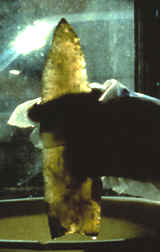
CLOVIS POINT #1990.1
EAST WENATCHEE CLOVIS SITE----WASHINGTON STATE
OWNED BY THE STATE OF WASHINGTON
PHOTO CREDIT & COPYRIGHT--DR. R.M. GRAMLY
Held in the hand and back lighted from a window this is the largest Clovis
point found in the cache. Here it is being washed in distilled water. |
|
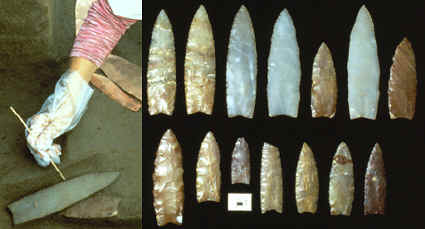
CLOVIS POINTS
EAST WENATCHEE CLOVIS SITE---WASHINGTON STATE
OWNED BY THE
STATE OF WASHINGTON
PHOTO CREDIT AND COPYRIGHT DR. R.M. GRAMLY
The picture on the left shows the excavation of the largest Clovis point,
number 1990.1, found on the site. It is laying on another point just below
it. The other objects at the top are metal cut outs that represent
previously excavated Clovis points.
The picture on the right shows all the Clovis points found on
the East Wenatchee Clovis site. They are made of banded and variegated
agates from local outcrops of this beautiful stone. |
|
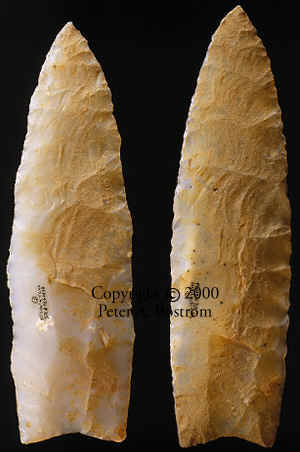
LARGE CLOVIS POINTS
EAST WENATCHEE CLOVIS SITE----WASHINGTON STATE
OWNED BY THE
STATE OF WASHINGTON
CLICK ON
PICTURE FOR LARGE IMAGE
This picture shows the patinated side of numbers 325 and 326 Clovis
points. |
|
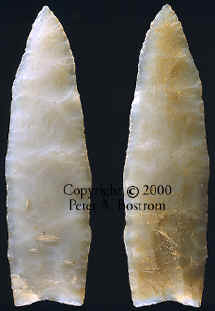 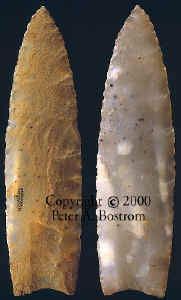
LARGE CLOVIS POINTS
EAST WENATCHEE CLOVIS SITE---WASHINGTON STATE
OWNED BY THE
STATE OF WASHINGTON
CLICK ON EACH
PICTURE FOR LARGE IMAGE
These two Clovis points, 1990.1 and 326, are shown double exposed so both
the patinated and clean sides can be seen. The Clovis point on the left
was the largest found in the cache. The one on the right is one of the
best examples in the cache. |
|
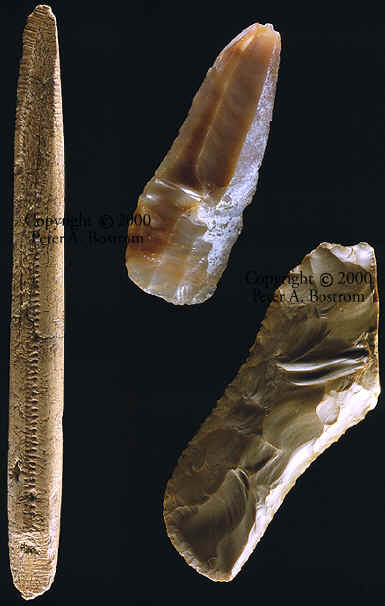
MISCELLANEOUS CLOVIS
BONE AND STONE ARTIFACTS
EAST WENATCHEE CLOVIS SITE---WASHINGTON STATE
OWNED BY THE
STATE OF WASHINGTON
The bone rod on the left is one of approximately 13 found in this cache.
They represent some of the most important artifacts discovered on the
site. Theories for their use range from sled runners to flintknapping
tools and foreshafts. The stone artifact at the top is a core remnant that
may have been used as a tool of some sort. The large uniface tool at the
lower right is the largest (6 3/8 inches) side-end scraper found on the
site. It's made of Jasper.
|
|
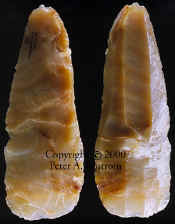
CORE
REMNANT--TOOL
EAST WENATCHEE CLOVIS SITE--WASHINGTON
CLICK ON
PICTURE FOR LARGE IMAGE
OWNED BY THE
STATE OF WASHINGTON
This core remnant may have been used as a tool of some sort. It has been
suggested that its intended use was as an adze. (Gramly, R.M., 1993,
pp43).
|
|
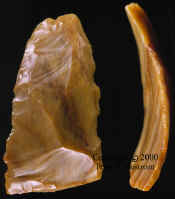
SIDE-SCRAPER
EAST WENATCHEE CLOVIS SITE---WASHINGTON
OWNED BY THE
STATE OF WASHINGTON
CLICK ON
PICTURE FOR LARGE IMAGE
This is one of five side-scrapers found on the
Wenatchee
Clovis site. This one was found in feature #2 a few meters east of the
main cache. It's made of agate and measures 4 1/4 inches long.
was as an adze.
(Gramly,
R.M., 1993, pp 43)
|







